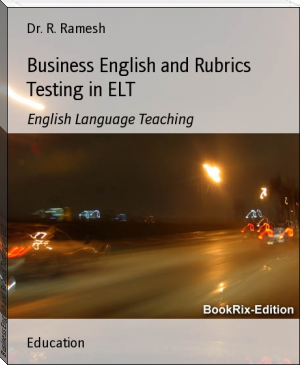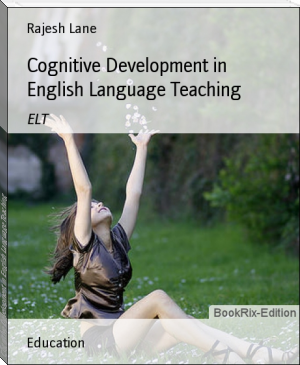Business English and Rubrics Testing in ELT by Dr. R. Ramesh (ebook smartphone txt) 📖

- Author: Dr. R. Ramesh
Book online «Business English and Rubrics Testing in ELT by Dr. R. Ramesh (ebook smartphone txt) 📖». Author Dr. R. Ramesh
In the activity ‘Information Technology’, there was a slight improvement. They could move to ‘B+’ grade from ‘B’ grade. Their rubrics scoring sheet was in the form of 3, 3, 4, 2 and total score was 12 out of 16. In this activity, their report was moderately organized and inaccurate in making sentences. In the task answering the questions, their ideas were somewhat unclear and their range of idioms was excellent.
In the activity ‘Telephoning’, the students’ performance was in ‘B+’ grade with the score 13 out of 16. The score was in 3, 3, 3, 4 form. They got 3 points (good) in first 3 tasks and 4 points (excellent) in final task (i.e.) group discussion. In rewriting the telephonic conversations and writing the telephonic message note they were able to present somewhat cohesive and logically organized. Their role play was good and group discussion was excellent because the ideas were stated clearly and interestingly.
The activity ‘Meetings’ projected a performed performance of the students with the score 14 out of 16. They got 3 points (good) in two tasks and 4 points (excellent) in two tasks. The score was in 3, 3, 4, 4 form. In this activity, the tasks writing an agenda and giving an informal speech, the thoughts of students were fairly organized and constructed in a good order. Their vocabulary knowledge and Mix and Match formations were excellent.
In the Nineth activity ‘e-mail’, the students’ performance was better than previous activity. They got 3 points (fair) in the first task and 4 points (excellent) in the remaining tasks. The rubric score of this activity was 15 out of 16 and in the form 3, 4, 4, 4. This is the activity with full of writing e-mail’s in different situations. The e-mail writing of the students were moderately organized in the first task and excellent in the remaining tasks. The usage of commands, words were clear and style of writing was excellent.
In the activity ‘Presentations’, the students performance was improved much better than first activity. The rubric scoring sheet of this activity was in the form 4, 4, 4, 3 and total score was 15 out of 16 with ‘A’ grade. Students scored 4 points (excellent) in three tasks and 3 points (good) in a task. Their descriptions were well organized form, in group discussion, acknowledges the idea of others, but their complex sentence structure was inaccurate (i.e.,) good not excellent.
In the activities eleventh and twelfth, the researcher has attained the aims and objectives of her “Specific Business English Course”. In both the activities memo writing and grammar / punctuations students showed excellent performance. All the four tasks in these activities secured 4 points (excellent) with ‘A+’ grades. The rubrics scoring sheets of this activity was in the form 4, 4, 4, 4 with the total score 16 out of 16. All over the performance of the students were excellent in these final activities.
Hypothesis Realization:
From the observation, hypothesis realization of these twelve activities is observed that a steady growth is seen in the students’ performance from the poor to the excellent level. This course brings out a huge development in the language skills such as listening, speaking, reading, writing and business communication skills such as effective presentations, discussion techniques, team meetings, creating powerful advertisements, etc. The students who were in this course research were able to learn to take notes, identify critical materials and explain their ideas in clear and accurate English, both in speech and in writing. Several tasks within the activity will present specific business concepts which will be used to extend and strengthen the students’ business subject knowledge.
This Specific Business English Course unconsciously upgrades the students in their communicative competence, such as in discourse competence, strategic competence, grammatical competence and socio-linguistic competence. The students got improvement in their business vocabulary and words / phrases which are used in all areas of business. They were excellent in comprehending, note-making, telephoning and making presentations.
This Specific Business English Course to develop English communication skills can be practiced wherever the context is similar. Further research can be made at different levels to strengthen the concept of bring a Specific Course in English Language to develop Communication Skills.
Thus it is observed that the complete mastery was the second language / English can be achieved only through learner friendly activities. The researcher has taken enough effort to bring out the favorable result to the maximum possible extent in developing the communication skills. It has no doubt that the course can be practiced through self-study and this reference material and the course can effectively be used ever to acquire the second language / English through context.
Bibliography
Allam, Qaiser Zoha. “Problems and Issues”. English Language Teaching in India. New Delhi: Atlantic, 1995.
Bargery, Geoffrey. English for Business. Oxford: Oxford University Press, 1973.
Baron, Christopher. “Why Rubrics, what Rubrics.” Testing and Evaluation 24 October 2003. 16 July 2008. <http://www.tech_nology.com/testing and evaluation / articles / teaching / rubrics>
Boughey, Chrisie. “Learn to write by writing to learn: a group work approach.” ELT Journal 51.2 (1997): 102-105.
Brown, Charles. Fundamental Concepts of Language Teaching. Oxford: Oxford University Press, 1982.
Chen, Yong. “From common core to specific.” The Asian ESP Journal 3.6 (2007): 22-31. 1 June 2008. <http://asian_esp_journal.com/yc.php>
Chilver, J. English for Business: A Functional Approach. Great Britain: Continuum, 1988.
Clifton, Jonathan. “Real Business English.” Modern English Teacher. 14.4 (2005): 29-32.
Cooper, Robert L. Testing Teaching of English as Second Language. Eds. Allen and Campbell. Bombay: Tata Mac Graw, 1972.
Crowther, John, and Alwyn. Business Roles 2. Great Britain: Cambridge University Press, 1999.
Ellis, Mark, and Christine Johnson. Teaching Business English. Oxford: Oxford University Press, 1994.
Emmerson, Paul, and Nick Hamilton. Five Minutes Activities for Business English. Great Britain: Cambridge University Press, 2005.
Flowerdew, John. “An educational, or process, approach to the teaching of professional genres.” ELT Journal 47.4 (1993): 305-316.
Goddard, Angela. The Language of Advertising. New York: Routledge Publications, 1998.
Guffey, Mary Ellen. Business Communication: Process and Product. Singapore: Thomson Asia Pte Ltd., 2000.
Harmer, Jeremy. How to Teach English: An introduction to the practice of English Language Teaching. Malaysia: Longman, 1998.
Hashim, Fuzirah and Zarina Othman. “The Demands and Expectations in ESP Adult Teaching: English for BBA Executives.” Journal of Education Technology. 3.1 (2006): 11-17.
Hollett, Mary. New Business Objectives. Oxford: Oxford University Press, 1989.
Howatt, A.P.R. A History of English Language Teaching. Oxford: Oxford University Press, 1984.
Hutchinson, T and A. Waters. “English for specific purposes: A learning -centred approach. Cambridge: Cambridge University Press, 1987.
Jones, Leo and Richard Alexander. New International Business English. Great Britain: Cambridge University Press.
Kapoor, A.N. Business Correspondence and Communication Skills. New Delhi: S. Chand & Company Ltd., 2004.
Kelly, James. “Business English - A new wave.” The Internet TESL Journal 9.3 (2003): 41-47. 16 July 2008. <http://iteslj.org/techniques/ kelly -Business English>
Kohli, A.L. Techniques of Teaching English. Delhi: Danpat Rai, 1996.
Krishnaswamy, N. and T. Sriraman. English Teaching in India: Past, Present and Future. Eds. R.K. Agnihotri and A.L. Khanna. New Delhi: Sage, 1995.
Lesikar, Raymond V., and Marie E. Flately. Basic Business Communication. New Delhi: Tata McGraw-hill Publishing Company Ltd., 2005.
Lukmani, Yasmeen. Evaluation in English Teaching: Perspectives on English Language Teaching. Eds. Ure and Velayndhan, Delhi: Macmillan, 1985.
Mackenzie, Lan. English for Business Studies. Great Britain: Cambridge University Press, 1997.
Monipally, Matthukuty M. Business Communication Strategies. New Delhi: Tata McGraw-Hill Publishing Company Ltd., 2000.
Mukalel, Joseph G. Approaches to English Language Learning. New Delhi: Taruna, 1998.
Nagaraj, Geetha. Write to Communicate. New Delhi: Foundation Books, 2004.
Nunan, David. Research methods in Language Learning. New York: Cambridge, 1992.
Nunn, Roger. “Designing rating scales for small group interaction.” ELT Journal, 54.2 (2000): 123-126.
Omelan, Lilia. “Mixing Business with pleasure” English Teaching Professional 4 (2003):40-41.
Panton, J.H. Modern Teaching Practice and Techniques. London: Longmans, 1945.
Penrose, John M. Advanced Business Communication. Singapore: Thomson Asia Pte Ltd., 2001.
Picken, Jonathan. “State of the ad: the role of advertisement in the EFL teaching.” ELT Journal 53.4 (1999): 249-251.
Pote, Michel, and Derek Wright. A Case for Business English. London: Pergamon Press Limited, 1985.
Quinn, C.N. “ESP: what does it mean.” The Internet TESL Journal. 1.3 (200): 151-162. 21 July 2008 <http://iteslj.org/articles/quinn_esp.html>
Richards, Jack C., and Rodgers, Theodore S. Approaches and Methods in Language Teaching: A Description and Analysis. Cambridge: Cambridge University Press, 1986.
Sharma, R.C., and Krishnan Mohan. Business Correspondence and Report Writing. New Delhi: TataMcGraw-Hill Publishing Company Ltd., 1978.
Sharma, Ramkumar. Problems and solutions of Teaching English. New Delhi: Janaki Prakashan, 1989.
Srivastava, H.S. Challenges in Educational Evaluation. New Delhi: Vikas Publishing House Pvt. Ltd., 1992.
Thompson, Tim. “Trump Card”. English Teaching Professional 53 (2007):
34-36.
Varghese, Paul C. Teaching English as a Second Language. New Delhi: Sterling Publishers Private Limited, 1989.
Wong, Viola, and Kwok Peony. “The use of authentic materials at tertiary level.” ELT Journal 49.4 (1995): 51-54.
Zahner, Louis, and Arthur L. Mullin. The English Language. Great Britain: Harcourt, Brace &World Inc, 1966.
Imprint
Publication Date: 11-26-2009
All Rights Reserved
 The desire to acquire knowledge about the surrounding world and human society is quite natural and understandable for a person. Life is so developed that an uneducated person will never occupy a high position in any field. Humanity in its mass, and each person individually, develops objectively, regardless of certain life circumstances and obstacles, but with different intensity. The speed of development depends on the quality of training.
The desire to acquire knowledge about the surrounding world and human society is quite natural and understandable for a person. Life is so developed that an uneducated person will never occupy a high position in any field. Humanity in its mass, and each person individually, develops objectively, regardless of certain life circumstances and obstacles, but with different intensity. The speed of development depends on the quality of training.




Comments (0)